
Processors of the 4th generation are significantly more productive than similar models of AMD of the 3rd generation, as well as Intel Core processors (benchmarks under the cut)
. AMD, which today almost completely owns the desktop computer market, has released two new lines of processors for desktops . This is the highly anticipated 4000 series on Zen2 architecture (7nm) with integrated Vega graphics, for the standard AM4 socket:
- six AMD Ryzen 4000 G-Series
- + three new Athlon 3000 G-Series
- six AMD Ryzen 4000 Pro
- + three new Athlon 3000 Pro
The Pro series completely coincides in technical characteristics with the standard G-Series, so in reality we are talking about nine new processors, six of which are 4000-series and three Athlon 3000-series.
Since the processors are suitable for existing motherboards with socket AM4, they are in great demand among those who build their own computer and want to upgrade. The 4000 series has been talked about since CES itself in January. Unfortunately, AMD disappointed everyone here: at first, new items are supplied only to integrators and OEM partners, retail prices have not yet been announced. We'll have to wait a bit.
The reason for this decision, AMD said, is that 80% of the chips are bought by OEM anyway, and the rejection of retail sales (20%) greatly simplifies production planning and logistics. The company promises to put them on retail “soon”.
Let's start with a list of six new Ryzen 4000 G-Series.
| Cores / Threads | Base
frequency |
Turbo | GPU Units | GPU frequency | TDP | |
| Ryzen 7 4700G | 8/16 | 3600 | 4400 | 8 | 2100 | 65 Watt |
| Ryzen 7 4700GE | 8/16 | 3100 | 4300 | 8 | 2000 | 35 watts |
| Ryzen 5 4600G | 6/12 | 3700 | 4200 | 7 | 1900 | 65 Watt |
| Ryzen 5 4600GE | 6/12 | 3300 | 4200 | 7 | 1900 | 35 watts |
| Ryzen 3 4300G | 4/8 | 3800 | 4000 | 6 | 1700 | 65 Watt |
| Ryzen 3 4300GE | 4/8 | 3500 | 4000 | 6 | 1700 | 35 watts |
Some regularity can be noticed in the list: six processors come in three pairs of 65 and 35 watts. In the "younger" version, the frequency and TDP are simply cut off, they no longer differ. Only one APU has a slightly reduced graphics frequency.
All processors are built on an 8-core Zen2 architecture with 8 Vega compute units, just like the mobile Ryzen Mobile 4000 presented earlier. The top-end Ryzen 7 4700G with a TDP of 65 W uses all 8 cores and 8 computing units of graphics. The compute module itself runs at a base frequency of 3.6 GHz (4.4 GHz turbo), and the graphics are at a crazy 2.1 GHz.
At the bottom of the lineup is the Ryzen 3 4300G with four cores and six Vega compute units. 3.8GHz base frequency, 4.0GHz turbo. Six graphics units operate at 1.7 GHz.
All APUs support DDR4-3200 memory, and all have eight PCIe 3.0 lanes for additional graphics cards. But it is rather a "relic" of the mobile version of the chip, for which such a technical decision was made. In fact, AMD assumes that the integrated graphics in the 4000 series are mostly sufficient for most users.
AMD Benchmarks
Disclaimer: AMD benchmarks are more advertising in nature and are not objective, independent tests.
Top-end Ryzen 4700G vs. Intel Core i7-9700 in media processing:

Comparison in top games at 1080p:

Same media processing and gaming benchmarks for Ryzen 4600G and Intel Core i5-9500:
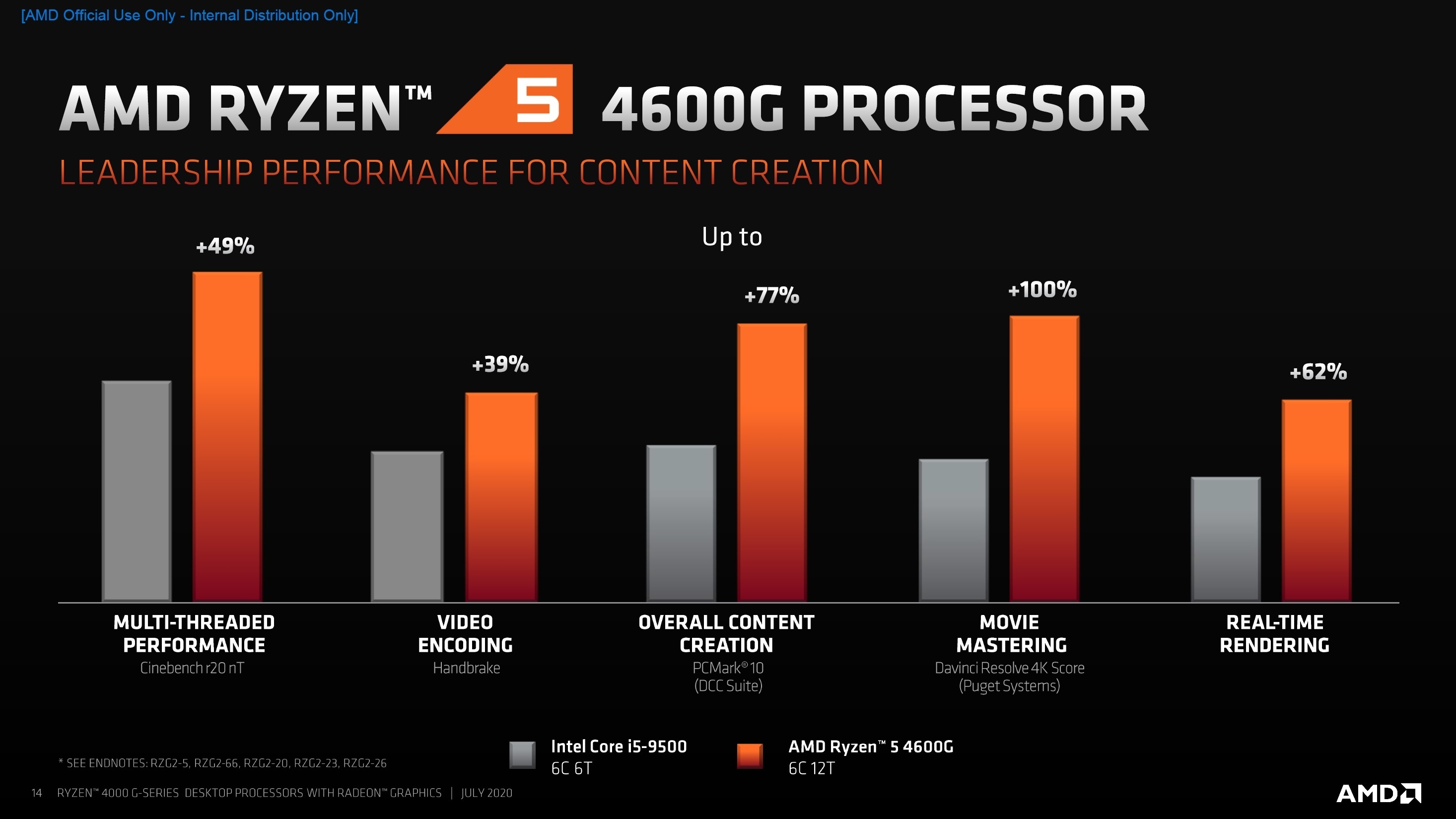
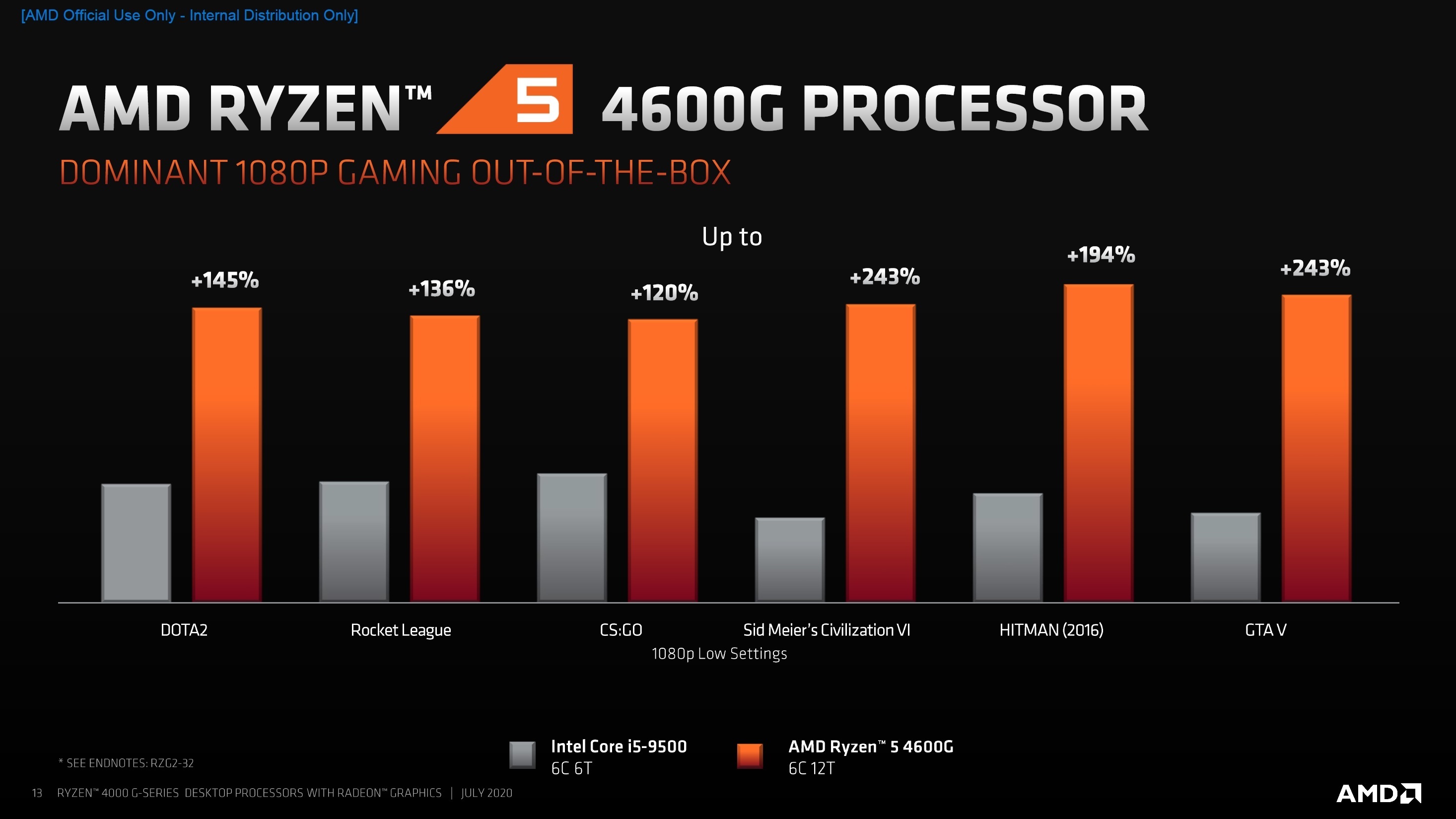
Finally, Ryzen 3 4300G vs. Core i3-9100:
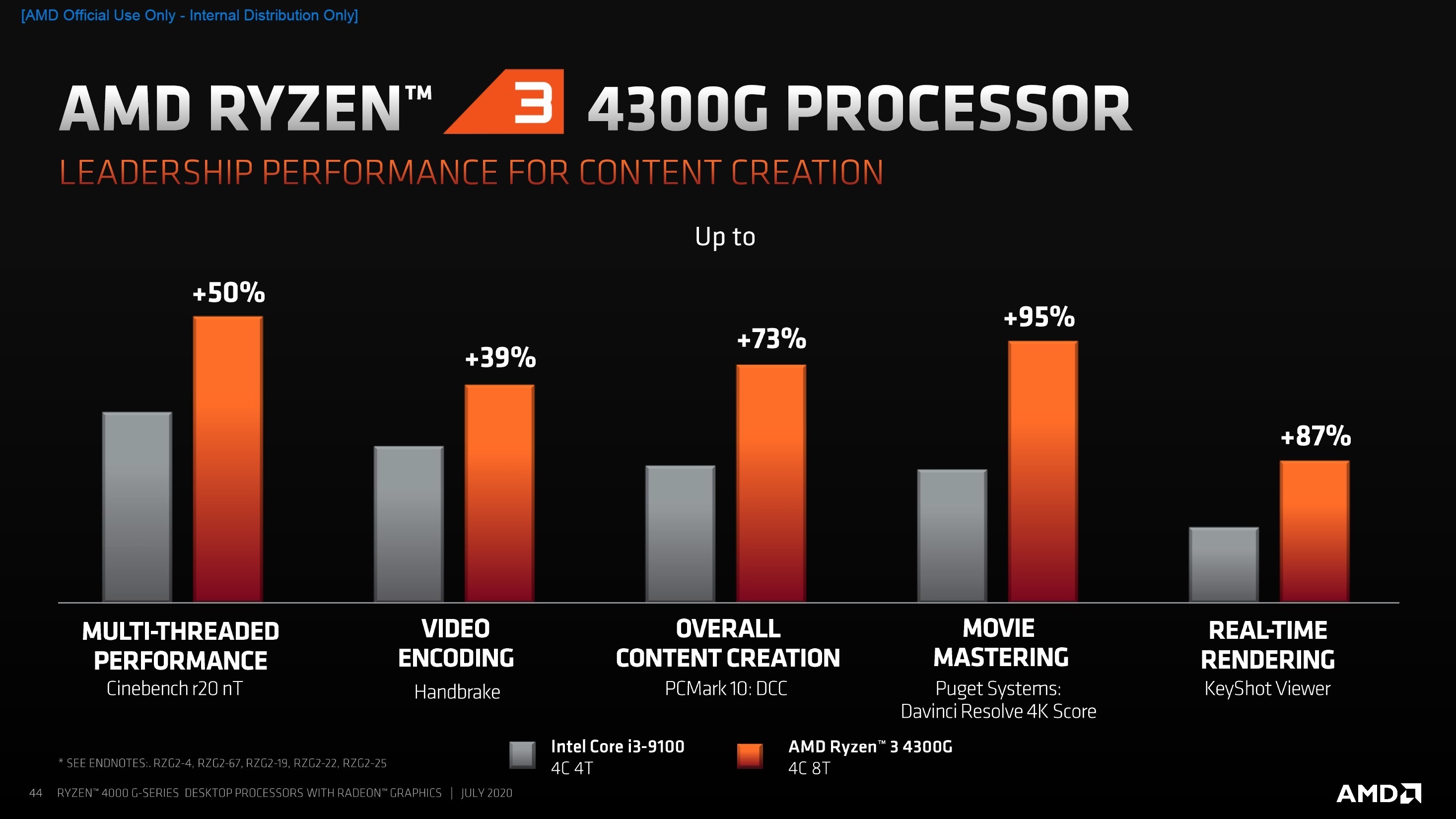
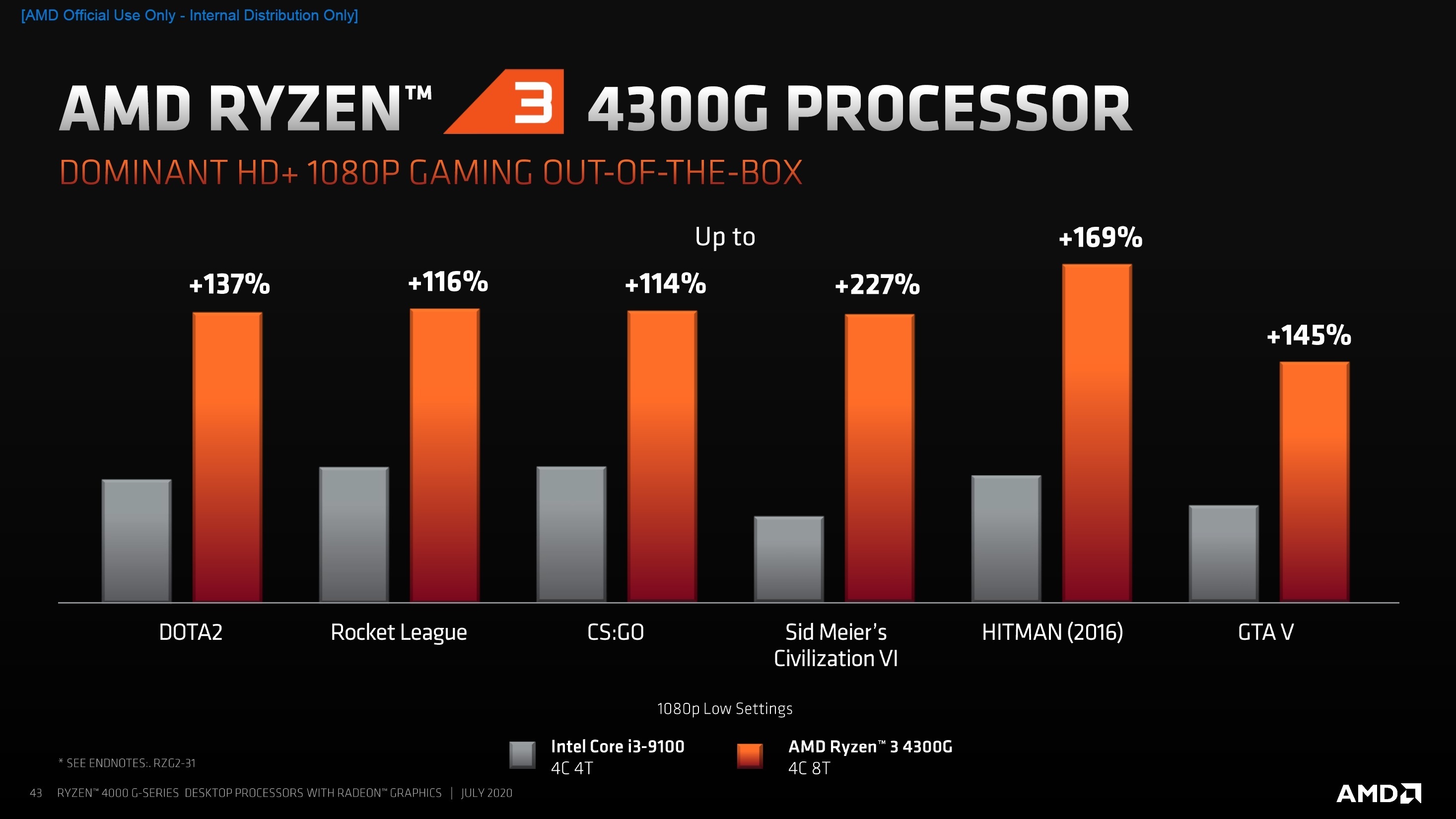
AMD compares its chips to 9th Gen Intel processors and claims that Intel doesn’t have much of a boost in the 10th Gen, other than slightly higher clock speeds, although Intel actually added Hyper-Threading in the 10th Gen, so the number threads have actually doubled (two threads per core), so 10th Gen Intel processors should be closer to AMD than slightly outdated 9th Gen chips.
In general, objective conclusions about performance can be made only after the publication of the results of independent tests.
Perhaps it would be more objective to compare the performance of the 4000 series with AMD's own processors of previous generations.
First, let's compare the Ryzen 5 4600G with the popular Ryzen 5 3400G.

The Ryzen 5 4600G clearly benefits from the upgrade to the new 7nm Zen2 architecture and improved Vega GPUs.
The budget Ryzen 3 4300G also slightly outperforms the Ryzen 3 3200G.
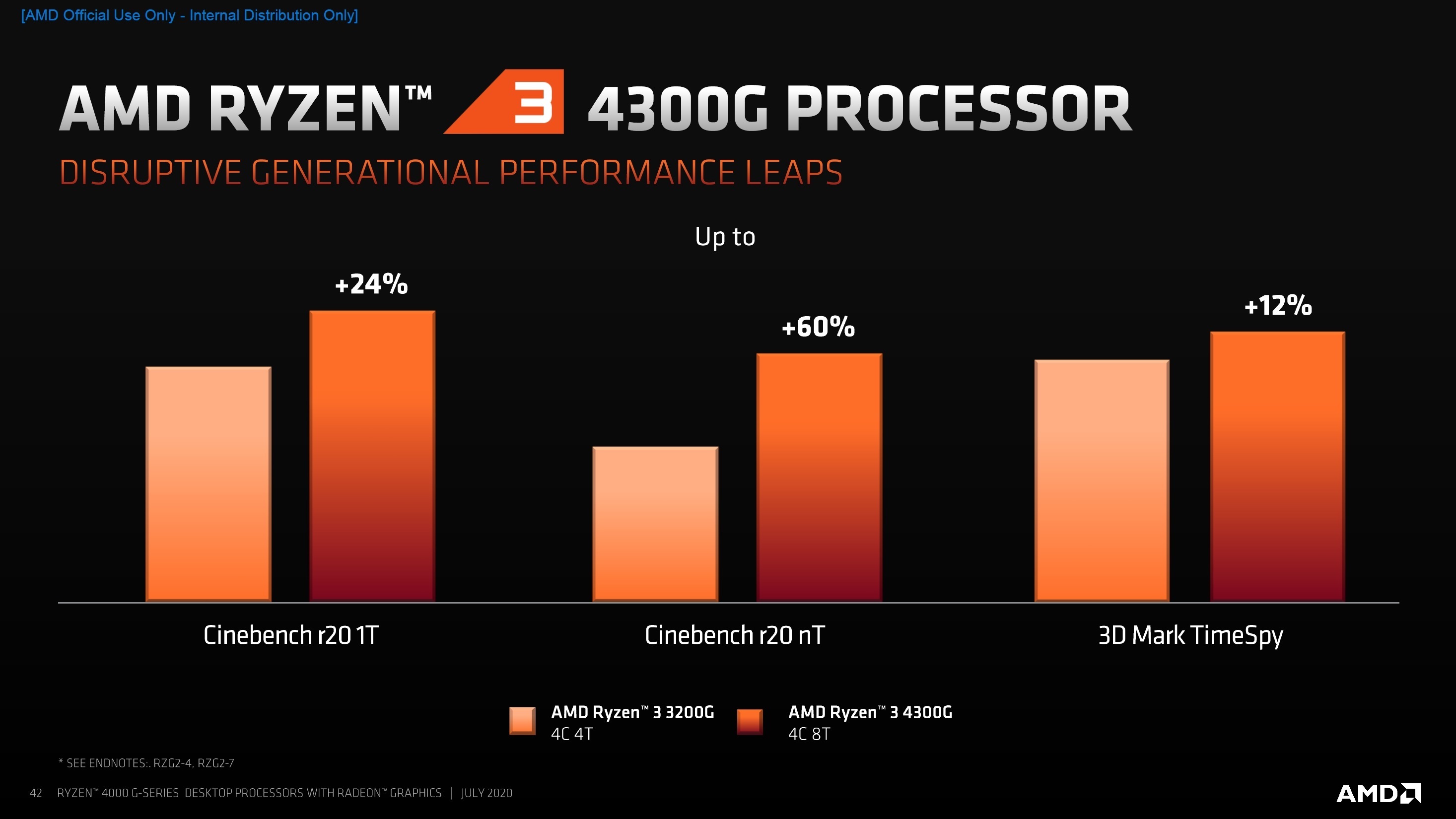
The AMD blog has published a separate news item about the Adobe Premiere Pro upgrade , which adds support for AMD GPUs, so that video processing on new processors is performed with hardware acceleration. The blog compares the performance of the mobile version of the Ryzen 7 4800U in a Lenovo Yoga Slim 7 laptop when encoding (exporting) a four-minute Apple ProRes 4444 4K 60P QuickTime video. Hardware and software encoding compared to Ryzen 7 4700U and Ryzen 5 4500U.
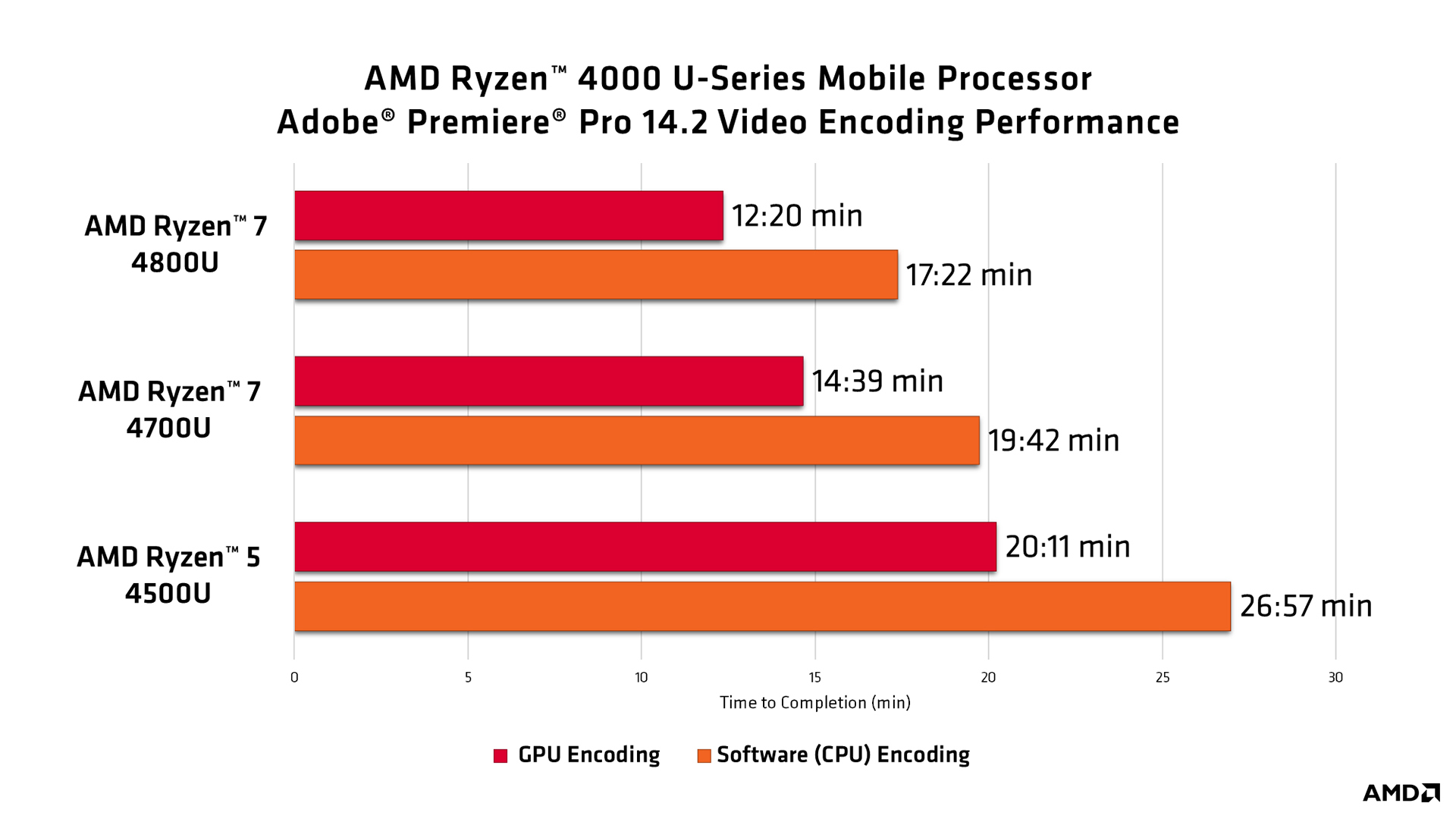
Ryzen 4000 Pro
Ryzen 4000 Pro processors are distinguished by the word Pro in the name, and the marking ends in 50, that is, Ryzen 7 Pro 4750GE, Ryzen 5 Pro 4650GE, and so on. They are positioned for corporate clients, therefore, they are equipped with several additional security and management features. Among them:
- full memory encryption;
- DASH management;
- OS stability (planned for 18 months of support);
- availability of processors for sale (planned for 24 months);
- guaranteed quality and reliability, advanced QA service.
New Athlon
Finally, here is a list of the three new Athlon 3000 series built on the old Zen + core, along with their Pro counterparts.
| Cores / Threads | Base
frequency |
Turbo | GPU Units | GPU frequency | TDP | |
| Athlon 3000G | ||||||
| Athlon Gold 3150G | 4/4 | ? | 3900 | 3 | ? | 65 Watt |
| Athlon Gold 3150GE | 4/4 | ? | 3800 | 3 | ? | 35 watts |
| Athlon Silver 3050GE | 2/4 | 3400 | - | 3 | ? | 35 watts |
| Athlon Pro 3000G | ||||||
| Athlon Gold Pro 3150G | 4/4 | 3500 | 3900 | 3 | 1100 | 65 Watt |
| Athlon Gold Pro 3150GE | 4/4 | 3300 | 3800 | 3 | 1100 | 35 watts |
| Athlon Silver Pro 3125GE | 2/4 | 3400 | - | 3 | 1100 | 35 watts |
These are the first processors to be named Athlon Gold and Athlon Silver, which means AMD is introducing new branding. There are few details about them, prices have not yet been published.
Let's hope AMD will start selling all of these processors at retail as soon as possible.